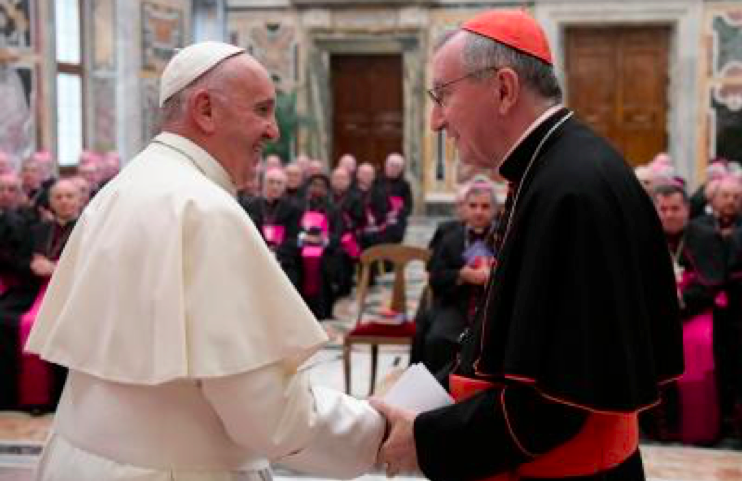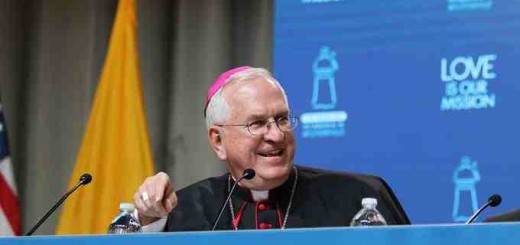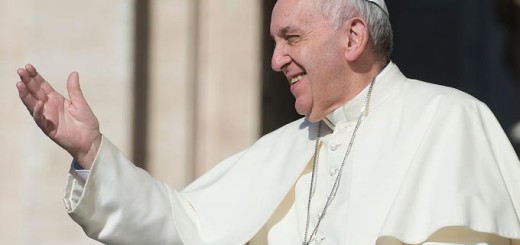C9 collegiality rules the church now!

Vatican Power Shift – VATICAN DISPATCH
By Gerard O'Connell, in America the national Catholic Review, Oct 12 2016
Pope Francis greets Cardinal Pietro Parolin, Vatican secretary of state, during a meeting with nuncios. (CNS photo/L'Osservatore Romano, handout)
(Note: Once upon a time it was “the Holy Father Church”, that is, the rule of one Man, a male person, keeping females at a distance as objects of temptation. It was that attitude that got shifted with the second Vatican council and its great spokes person Cardinal Suenens of Belgium the advocate of “Collegiality, coresponsibility and subsidiarity.” He even wrote the book: “Coresponsisbility.” Now Francis has brought it to perfection with the appointment of nine cardnal advisers to Pope from around the globe.Originally it had only 8 members, now it has become the official: C9. Since 2013 it has already met 16 times, each meeting lasting 3 days.
What Francis has already implemented at the top level is ordered to be implemented at the parish and diocesan level by the constitution of the Pastoral and Financial councils at parish and diocesan levels which is resisted strongly by conservative Indian bishops with an autocratic and dictatorial mind set. Old habits die hard. For proof count the number of dioceses in India which has Pastoral and financial commissions to assist the Parish priest  and the local bishop who are not to rule according to their whims and famcies. This must be brought into force by the insistence of a vocal laity ready to hold their heads high and not ready to bend their heads to the insolent might of dictatorial bishops whose numbers fortunately are decreasing. james kottoor, editor)
and the local bishop who are not to rule according to their whims and famcies. This must be brought into force by the insistence of a vocal laity ready to hold their heads high and not ready to bend their heads to the insolent might of dictatorial bishops whose numbers fortunately are decreasing. james kottoor, editor)
Has there been a power shift in the Vatican under Pope Francis? Has the Secretariat of State lost its traditional role as the pope’s main adviser, being replaced by the council of cardinals that Francis established soon after his election? Where will power lie once the reform of the Roman Curia has been completed?
These questions are being asked in the Vatican today as the council of cardinal advisers plays a highly significant role in advising, offering suggestions or making proposals to the Argentine pope.
On March 17, 2013, four days after his election, Francis invited Cardinal Óscar Rodríguez Maradiaga to lunch and informed him of his decision to establish this council. He had already decided on its membership and asked Maradiaga to be its coordinator.
He then informed the secretary of state of his decision and asked that it be made public. But that did not happen until April 13, when the Vatican issued a press communique and published the names of the eight cardinals Francis had chosen as advisers.
Francis formally established the council in a chirograph on Sept. 28, 2013. There he revealed that in the pre-conclave meetings of cardinals it was suggested that the next pope “establish a small group of bishops from the different parts of the world” whom he “could consult on specific issues, either individually or as a group.” Francis said that after his election he concluded such a body “would be of considerable assistance” to him “in carrying out the pastoral ministry of the Successor of Peter.”
From his experience as provincial superior of the Jesuits in Argentina he knew well the value of advisers, and in the chirograph he assigned them a dual role: “to help” him “in the government of the universal church” and “to study a project” for the reform of the Roman Curia.
He said he wanted the council to be “a further expression of episcopal communion” and “of the assistance” that bishops throughout the world “can offer to the Petrine office.” He therefore chose eight cardinal advisers: seven from dioceses on different continents and one from the Roman Curia. He appointed an Italian bishop as its secretary. In April 2014 he named Cardinal Pietro Parolin, the secretary of state, as its ninth member (hence the nickname “The C9”). Before that he had only been invited to its sessions.
Francis convened the council’s first meeting for Oct. 1-3, 2013. Since then it has met 16 times. Each meeting lasts three days; Francis is present for most of the time. In addition, he has consulted its individual members on numerous occasions.
A glance at the range of topics discussed by the council is quite revealing and raises the question as to whether the real power has moved from the Roman Curia to this body.
The C9 has devoted much time to the reform of the Roman Curia. It makes proposals regarding structures and nominations, but Francis takes the final decision. This has resulted in the establishment of the Secretariats for the Economy and for Communications, and in the creation of two new dicasteries (departments): for the Laity, Family and Life; and for Integral Human Development. It is now reviewing the work and structure of the Vatican’s tribunals, congregations and the secretariat of state. The reform process could take some years more.
Besides all this, the C9 has been involved in the revision of the regulations for the Synod of Bishops, the preparation for the synods on the family, the institution of the commission for the protection of children and the reform of the Governorate of Vatican City State.
Whereas in the past popes were largely dependent on the Roman Curia, especially on the Secretariat of State, for advice on major issues, that is no longer the case. While Francis meets periodically with the heads of all Roman Curia offices and has regular one-to-one sessions with its senior officials, he is no longer limited to their input because he has the C9. He thus governs with greater independence from the Roman Curia than his predecessors.
As one C9 cardinal told me recently, “Pope Francis truly believes in a collegial style of government; we see this clearly in our meetings. He listens carefully and takes our advice seriously.” But not everyone in the Roman Curia is happy at this development, as one senior Vatican official told me recently. (Gerard O’Connell is America’s Vatican correspondent. America’s Vatican coverage is sponsored in part by the Jesuit communities of the United States)
















